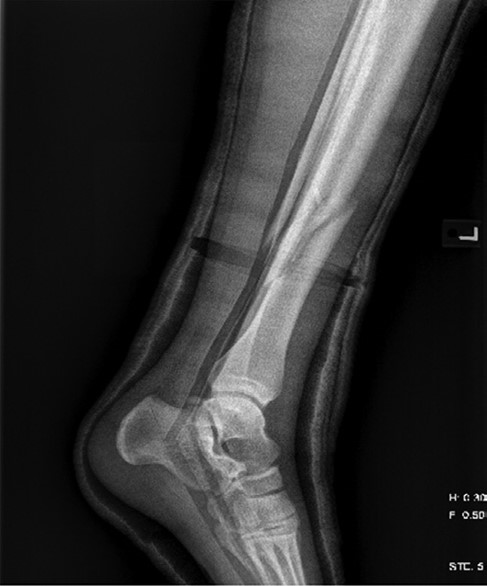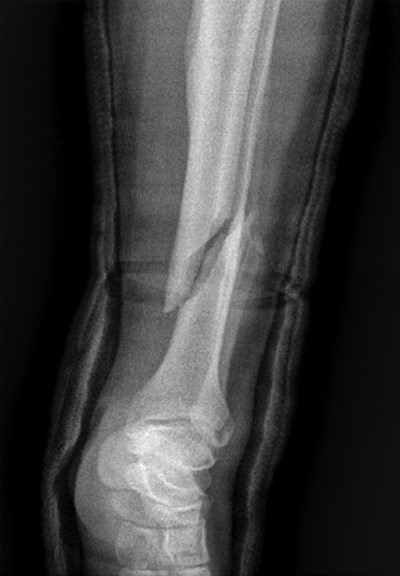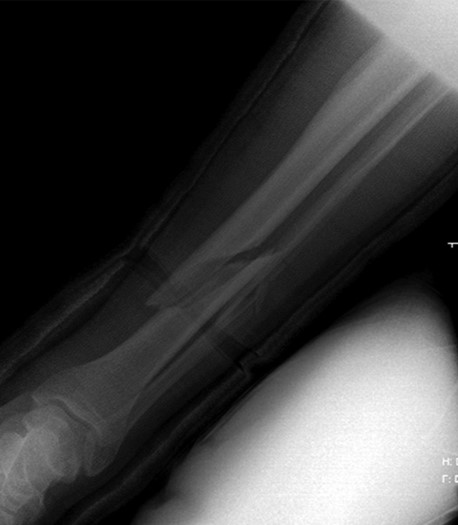How would you treat a 14-year-old football player with closed fracture of the right tibia?
The presumed challenge is a low-energy, closed, spiral distal diaphyseal tibia and fibula fracture at the same level, and likely in a male. The first issue that needs to be addressed is obtaining quality films of the ankle, knee and tibia shaft outside of splintage. “X-rays of the joint above and the joint below” is an important axiom to apply here.
The estimated incidence of ipsilateral ankle fractures, usually occult posterior malleolus, associated with distal tibia shaft fractures is 25% to 39%. Furthermore, I would want to be convinced the tibial tubercle physis is nearly closed to determine whether to nail the fracture. For the purpose of the case at hand, I will assume the injury is isolated to the tibia and fibula diaphysis, the distal neurologic and vascular examination reveals no pathology, and the patient is close to maturity.

Peter A. Cole
Operative approach
Based on the track record for tibia shaft fracture treatment, I believe a discussion of the risks and benefits of operative vs. nonoperative treatment is warranted with the patient and his parents. I would also present my preference for tibia nailing. Together, a decision would be made for treatment.



A 14-year-old football player sustained a blow to right tibia, resulting in a closed fracture. Reduction was performed by a local physicians. Anteroposterior (A), lateral (B) and oblique (C) radiographs of the tibia and fibula are provided. What would you do?
Source: Kelly JD
The primary downside to nailing the fracture is the anticipated anterior knee pain, which is common after this procedure. Although I believe surgical technique regarding entry site matters, the type of technique for insertion and entry site and nail removal is still associated with a high incidence of knee pain even years after the injury. Union rates after closed tibial nailing are almost 100% and are associated with a low malunion rate in diaphyseal fractures. Generally, the patient can begin immediate weightbearing as tolerated and with little risk of changing alignment. Even if the patient were lost to follow-up, he or she will likely be fine. I have found a small subset wish to pursue removal of the distal locking screws because they can be prominent and bothersome along the distal medial cortex. Nail removal is rarely required.
Nonoperative approach
Some patients may wish to avoid surgery. Few studies in orthopedics capture the numbers of Sarmiento and colleagues’ historic work on functional bracing for tibia shaft fractures. In a landmark series of 780 such fractures, results of closed injuries revealed an average healing time of 17.4 weeks, shortening less than 1 cm in 90%, less than 5° of malalignment in 75%, and a union rate of 97.5%. In another study of 450 distal third tibia shaft fractures treated with functional bracing, a 99.1% union rate and less than 8° of deformity in 90% of fractures occurred.
Two issues are problematic with this nonoperative approach. First, even a modest level of malunion may result in dissatisfied patients. In fact, rotational deformity was never measured in the studies by Sarmiento and colleagues and Sarmiento and Latta and is likely to be an issue in rotationally unstable fractures treated with below the knee bracing. For nonoperative treatment, I prefer to treat the patient for 4 weeks to 6 weeks in an above-knee cast before converting to a functional fracture brace to allow for weightbearing.
Second, close follow-up is required to allow cast checks and modify the cast with wedging to correct alignment when necessary. Long-leg casts during this period are less accepted by patients today, in whom mobility and return to normalcy are expectations held at a premium.
References:
Boraiah S. Clin Ortho Rel Res. 2008;doi:10.1007/s11999-008-0224-5.
Kukkonen J. J Trauma. 2006;60(5):1058-1060.
Sarmiento A. J Bone Joint Surg Br. 1989;71(4):602-609.
Sarmiento A. Clin Orthop Relat Res. 2004;(428):261-271.
Peter A. Cole, MD, is from the Department of Orthopaedic Surgery, Regions Hospital, and the University of Minnesota, St. Paul, Minn.
Disclosure: Cole receives consulting fees/honoraria from AONA and AO International, is a consultant to Johnson & Johnson (DePuy Synthes), and has stock/stock options with BoneFoams Inc. LLC.
